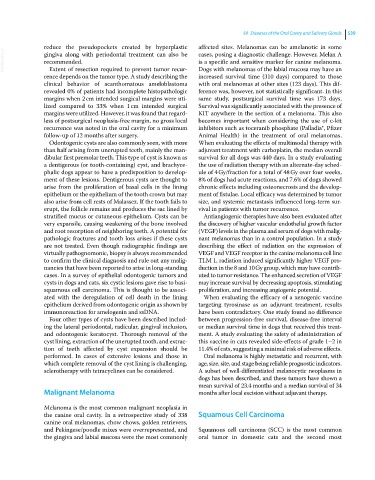Page 571 - Clinical Small Animal Internal Medicine
P. 571
50 Diseases of the Oral Cavity and Salivary Glands 539
reduce the pseudopockets created by hyperplastic affected sites. Melanomas can be amelanotic in some
VetBooks.ir gingiva along with periodontal treatment can also be cases, posing a diagnostic challenge. However, Melan A
is a specific and sensitive marker for canine melanoma.
recommended.
Extent of resection required to prevent tumor recur
rence depends on the tumor type. A study describing the Dogs with melanomas of the labial mucosa may have an
increased survival time (310 days) compared to those
clinical behavior of acanthomatous ameloblastoma with oral melanomas at other sites (123 days). This dif
revealed 0% of patients had incomplete histopathologic ference was, however, not statistically significant. In this
margins when 2 cm intended surgical margins were uti same study, postsurgical survival time was 173 days.
lized compared to 33% when 1 cm intended surgical Survival was significantly associated with the presence of
margins were utilized. However, it was found that regard KIT anywhere in the section of a melanoma. This also
less of postsurgical neoplasia‐free margin, no gross local becomes important when considering the use of c‐kit
recurrence was noted in the oral cavity for a minimum inhibitors such as toceranib phosphate (Palladia®, Pfizer
follow‐up of 12 months after surgery. Animal Health) in the treatment of oral melanomas.
Odontogenic cysts are also commonly seen, with more When evaluating the effects of multimodal therapy with
than half arising from unerupted teeth, mainly the man adjuvant treatment with carboplatin, the median overall
dibular first premolar teeth. This type of cyst is known as survival for all dogs was 440 days. In a study evaluating
a dentigerous (or tooth‐containing) cyst, and brachyce the use of radiation therapy with an alternate‐day sched
phalic dogs appear to have a predisposition to develop ule of 4 Gy/fraction for a total of 48 Gy over four weeks,
ment of these lesions. Dentigerous cysts are thought to 8% of dogs had acute reactions, and 7.6% of dogs showed
arise from the proliferation of basal cells in the lining chronic effects including osteonecrosis and the develop
epithelium or the epithelium of the tooth crown but may ment of fistulae. Local efficacy was determined by tumor
also arise from cell rests of Malassez. If the tooth fails to size, and systemic metastasis influenced long‐term sur
erupt, the follicle remains and produces the sac lined by vival in patients with tumor recurrence.
stratified mucus or cutaneous epithelium. Cysts can be Antiangiogenic therapies have also been evaluated after
very expansile, causing weakening of the bone involved the discovery of higher vascular endothelial growth factor
and root resorption of neighboring teeth. A potential for (VEGF) levels in the plasma and serum of dogs with malig
pathologic fractures and tooth loss arises if these cysts nant melanomas than in a control population. In a study
are not treated. Even though radiographic findings are describing the effect of radiation on the expression of
virtually pathognomonic, biopsy is always recommended VEGF and VEGF receptor in the canine melanoma cell line
to confirm the clinical diagnosis and rule out any malig TLM 1, radiation induced significantly higher VEGF pro
nancies that have been reported to arise in long‐standing duction in the 8 and 10 Gy group, which may have contrib
cases. In a survey of epithelial odontogenic tumors and uted to tumor resistance. The enhanced secretion of VEGF
cysts in dogs and cats, six cystic lesions gave rise to basi‐ may increase survival by decreasing apoptosis, stimulating
squamous cell carcinoma. This is thought to be associ proliferation, and increasing angiogenic potential.
ated with the deregulation of cell death in the lining When evaluating the efficacy of a xenogenic vaccine
epithelium derived from odontogenic origin as shown by targeting tyrosinase as an adjuvant treatment, results
immunoreaction for amelogenin and ssDNA. have been contradictory. One study found no difference
Four other types of cysts have been described includ between progression‐free survival, disease‐free interval
ing the lateral periodontal, radicular, gingival inclusion, or median survival time in dogs that received this treat
and odontogenic keratocyst. Thorough removal of the ment. A study evaluating the safety of administration of
cyst lining, extraction of the unerupted tooth, and extrac this vaccine in cats revealed side‐effects of grade 1–2 in
tion of teeth affected by cyst expansion should be 11.4% of cats, suggesting a minimal risk of adverse effects.
performed. In cases of extensive lesions and those in Oral melanoma is highly metastatic and recurrent, with
which complete removal of the cyst lining is challenging, age, size, site, and stage being reliable prognostic indicators.
sclerotherapy with tetracyclines can be considered. A subset of well‐differentiated melanocytic neoplasms in
dogs has been described, and these tumors have shown a
mean survival of 23.4 months and a median survival of 34
Malignant Melanoma months after local excision without adjuvant therapy.
Melanoma is the most common malignant neoplasia in
the canine oral cavity. In a retrospective study of 338 Squamous Cell Carcinoma
canine oral melanomas, chow chows, golden retrievers,
and Pekingese/poodle mixes were overrepresented, and Squamous cell carcinoma (SCC) is the most common
the gingiva and labial mucosa were the most commonly oral tumor in domestic cats and the second most

